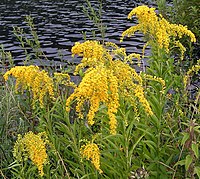
Photo from wikipedia
Understanding the role of genetics in biological invasions has become an important aspect for modern plant ecology. Many studies suggest that increased ploidy level benefits the success of an invasive… Click to show full abstract
Understanding the role of genetics in biological invasions has become an important aspect for modern plant ecology. Many studies suggest that increased ploidy level benefits the success of an invasive species, but the basis for this phenomenon is not fully understood. In its native, North American range, Solidago gigantea has three geo-cytotypes comprising di-, tetra- and hexaploid populations, while in Europe, where it is highly invasive, S. gigantea stands are composed primarily of tetraploid individuals. Our study investigates whether North American hexaploids can induce a greater risk of invasion, due to their higher performance in a non-native range, as compared to the existing tetraploids of that range. We performed greenhouse and common garden experiments along with microsatellite analyses to test whether differences in chromosome number and origin of the species mean superior fitness in the introduced range. Genetic diversity was significantly higher in the native hexaploid populations (AR = 6.04; Hₑ = 0.7794), rather than the non-native tetraploid populations (AR = 4.83; Hₑ = 0.6869). Furthermore, differentiation between geo-cytotypes was moderate (ρST = 0.1838), which was also confirmed by their clear segregation in principal component analysis and structure analyses, proving their different genetic structure. In contrast to genetic diversity, the non-native tetraploid geo-cytotype performed better in the common garden experiment, implying that higher genetic diversity does not always mean better success. Our results suggest that native hexaploids do not present a greater risk, as assessed by their performance in the introduced range, when compared to the non-native tetraploids, as was suggested by previous studies. Nevertheless, their introduction is still undesirable due to their different genetic structure, which, through hybridization, could give a new drive to the invasion of S. gigantea.
Journal Title: Journal of Plant Ecology
Year Published: 2018
Link to full text (if available)
Share on Social Media: Sign Up to like & get
recommendations!